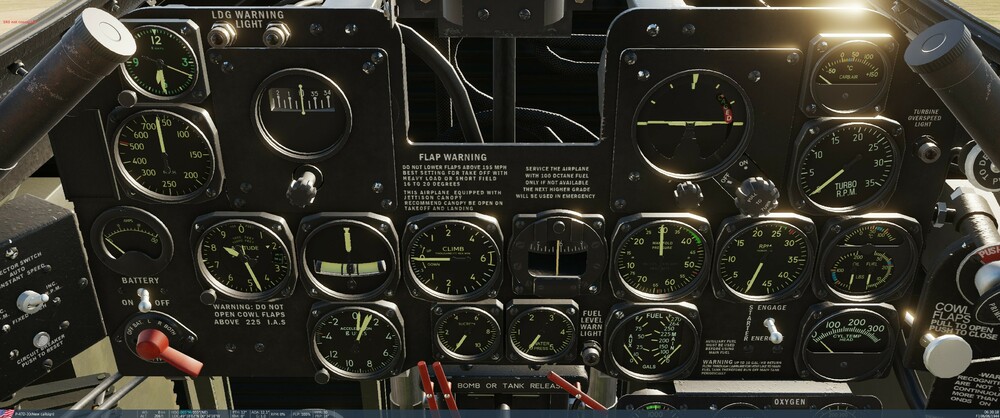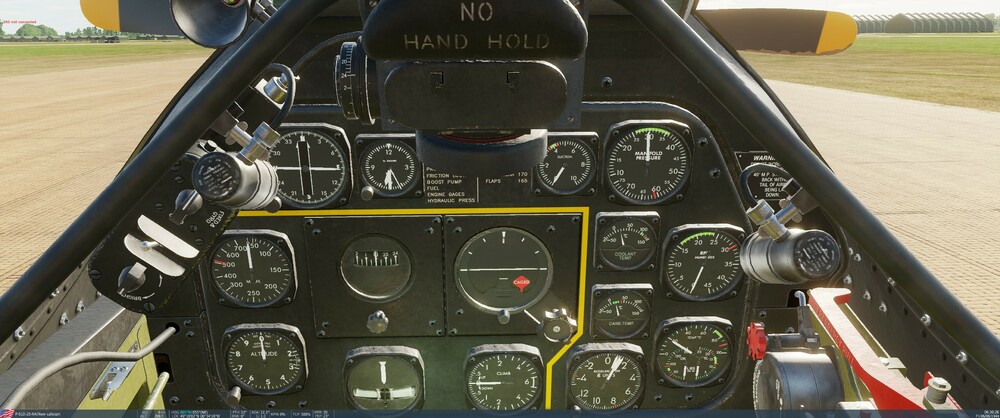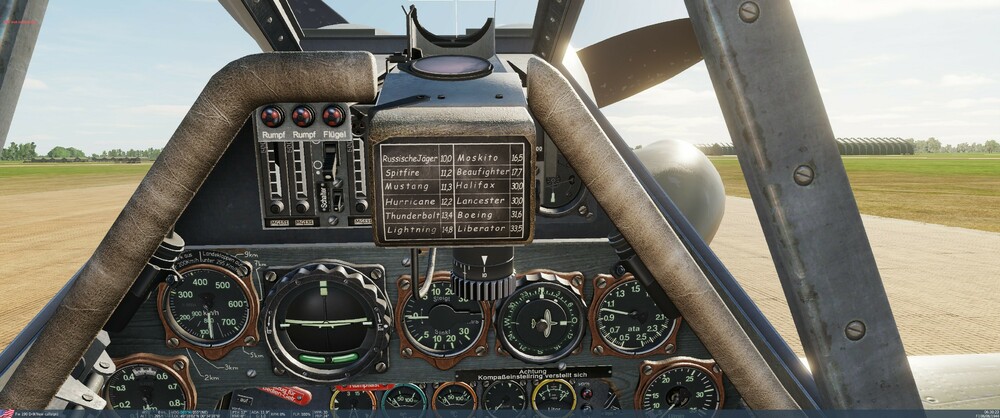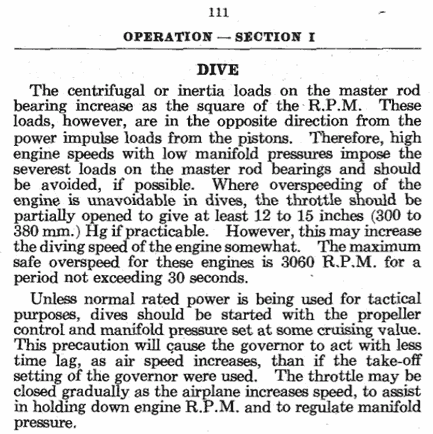-
Posts
319 -
Joined
-
Last visited
Content Type
Profiles
Forums
Events
Everything posted by kablamoman
-
Virpil T-50 CM2/3 are pretty good as you can use the split throttle for boost and throttle, and the flap lever axis inboard for the RPM.
-
I have not encountered this issue. Is there some joystick button testing/display software you can run at the same time to see if your device is registering a button press when it happens, maybe?
-
There’s not a whole lot extra to worry about in normal operation, nor even much you can do if there’s any kind of damage. Either you get peppered in non-critical areas (wings, for example) and keep flying. Or you take a critical hit (most commonly the rad or something that results in some kind of coolant leak), and then it’s just a matter of time. Running reduced RPM and lowering the desired coolant temp with the knob might give you a bit of extra time before the engine seizes, but it’s dynamic and also depends on where you’re leaking and how badly. I’ve been peppered with some spit .303, had a small coolant leak, but it was minor and I was able to get back to a field safely without having to pull back power (was still running). But other times, with more severe leaks it’ll burn off and overheat a lot faster. The oil coolant heat exchanger is tied into the same system, so either way you’re kind of hooped. I’ve yet to have my MBG damaged, but I’d imagine that would manifest as some kind of erratic, non-responsive, or overboosting throttle. I wouldn’t worry about that except in that very specific circumstance. In real life the handle was used in cold starts as a kind of choke for smoother starting in cold temps. In the sim you’ll never really need to do anything with it.
-

WWII updates in the coming patch?
kablamoman replied to Cool-Hand's topic in Western Europe 1944-1945
I think we’re all pretty desperate for updates to the WWII modules. Would be nice for ED to spare a modicum of dev resources every once in a while to fix some of the longstanding bugs and otherwise clean up some of the modules. After SoW closed there was a tiny reaction and response that resulted in some modest fixes being rolled out, but that quickly came to a stop. It is an unbelievable shame that a community’s primary server has to shutter its doors in protest to get even a small response from the team reiterating its commitment to the era. Do we have to lose even more frustrated players and server operators for ED to send some TLC the way of warbirds? -
@NineLine As -303- mentioned, it's been over a decade. Any chance we can actually get a fix for this long-standing problem?
-
Just to add more fuel to the mixture, I think you could make a strong argument for calling it "Engine RPM Control" as that's what you're selecting with the lever and seeing on the gauge. In contrast to this, you can manually set the pitch of the prop blades in the 109 or Anton, and both have a gauge that directly shows you the blade angle.
-
A while back I had been curious about high-speed performance and how it related to engine RPM settings, and I actually ended up running the numbers for the Mustang prop tip speed just to see if it could play a role in reduced prop efficiency at high speed. That is to say, I was wondering if I could get better performance by reducing engine RPM slightly in max level flight or a high-speed dive. This was based on the reduction gear outputting 1437 prop RPM at 3000 engine RPM (0.479:1), and a 134" propeller diameter: At sea level and roughly max level speed (355 MPH or 308.5 KTAS), it came out to around 0.88 mach for the prop tip speed. For that same TAS at 35,000', the tips would be at 1.02 mach. 0.88 is starting to get to the point at which a conventional propeller design starts to bump up against inefficiencies due to wave drag/supersonic flow over the thicker portions of the prop blades -- it is my understanding that these start to creep in and become increasingly worse anywhere from mach .84 to .88 depending on prop design (more modern designs with thin, swept blade tips, try to delay this onset as much as possible). It doesn't seem like a coincidence that the Mustang has been tuned to operate very close to this threshold at the top end of its speed range. All of this to suggest that wave drag and tip speed problems with efficiency should only really factor in at the higher end of the speed range, and more so at higher altitudes. Whether DCS models this and to what extent, I am not sure -- but it shouldn't be a factor low to the ground at lower speed (eg. takeoff, climb). @Nealius, with regards to windmilling, and how the mechanism by which this creates drag in the absence of power works, this video sums it up nicely (see time 12:10): It could be thought of as a kind of auto-rotation that creates lift, but in the direction opposing the aircraft's normal thrust line because the blade ends up flying with a negative angle of attack -- almost as if it were a reverse autogyro. That entire video is pretty well done and worth a watch. The prop and all of its widgets and doodads can be thought of mechanism for transferring energy between the engine and the relative airflow. It's important to remember that it can go both ways: In the absence of engine power, it'll start to extract energy from the relative airflow in the form of drag. With a constant speed prop, to think of the prop lever as something you use to select a blade pitch directly is wrong, as the actual blade angle/pitch will depend on airspeed and engine power output (both MP & RPM) and will vary dynamically in response to those things changing -- instead, think of the lever as something you use to select the rate of energy transfer between the engine and the airflow. You choose the direction of that transfer with the throttle. For example, if you want max power to accelerate (transferring from engine to airflow), push both levers forward. If you want to extract the most energy from the airflow in the form of drag, push the prop lever forward, but pull the throttle to idle. If you wanted to minimize that transfer at idle throttle to reduce drag from the airflow, pull the prop back all the way as well. With this analogy you can also see how high engine MP settings with a low transfer rate (reduced RPM) might be problematic -- the energy the engine is generating has nowhere to go, as its transfer to the airflow is inhibited, so you end up with an excess of potentially damaging heat and pressure.
-
Just the power is fine, you will never need anything else.
-
It's very useful and will save you from getting bounced. It is also worth binding the toggle for power, as you will sometimes receive nuisance warnings from friendlies or from ground returns below about 3,000' AGL. When you first turn it on, I believe it has a timer and won't activate immediately (to prevent it from being activated by the ground returns shortly after departure).
-
It's still super competitive, especially in the 6000-8000 meter altitude block. Its biggest threat is the Mustang. The 47 will start to be a threat only at extreme altitudes. The spit is never a issue at any altitude as it simply can't catch you. The Mustang (and 47, if the player knows how to maximize its dive) absolutely will out-dive the Dora though -- you'll do better to get away in those instances with an extension and a shallow climb. But if you're stuck within guns range, use the Dora's roll to alternately pull to the attacker's belly and out of plane after a split-s. If you can shake them, try to reset and extend with a shallow climb or lose them in cloud. Without MW50 it will be close enough to matching the Mustang's sustained turn with takeoff flaps to go quite a few circles, but it's tight and a stupid thing to do -- you'll either get third-partied or if he's decent he may eventually catch you after quite a few turns around the church steeple. For instantaneous turn, you can drop flap all the way to landing and pull insane G to get shots off without damaging the flaps. You've got to fly it defensively (it's very good at this) and avoid getting into mindless turn fights.
-
There are indeed quite a few dedicated Mosquito aficionados. I think they have a system where it can be ferried over from England to open slots in France.
-
Should spend some time on the Project Overlord server. A lot of high-flyers there for sure. It's quite common to joust with opponents in the block from 25,000 - 35,000 feet there. Dora holds its own up to about 26k even with the MW50 disabled. Above that, even though it could already turn, the 109 starts to really shine in terms of speed (again, even if it doesn't have MW50). Mustang is a great performer in general at most altitudes and the biggest threat to axis aircraft by far, in my estimation (above 30k the 109 and jug start flexing on it). The Anton is definitely at a disadvantage against almost everything except maybe spits and jugs down low, but it's still quite popular for air-to-ground stuff and coordinated formations of A8s in a dogfight can still be lethal. The ATA boost for the Anton would definitely be welcomed by almost all the players I know.
-

Looking for a real Mosquito compass deviation card, anyone?
kablamoman replied to Lau's topic in DCS: Mosquito FB VI
FYI, it seems to be a bug with all remote compass installations for the WW2 modules. Although I'm not sure which model of compass is used in the Mosquito I am reasonably certain it shouldn't affect the p51 or the axis birds in the same way you detailed (but it does at the moment). Some additional info from this thread where I did a bit of research on the remote indicating compass in the mustang: https://forum.dcs.world/topic/264224-cannot-calibrate-gyro-with-mag-compass/ -

investigating Cannot calibrate Gyro with Mag Compass
kablamoman replied to Nealius's topic in Bugs and Problems
A little update with some more clarification on the "flux gate" shown in the diagrams, in case anybody is interested. It is not a flux valve compass like in a more modern installation, but a simple toroidal coil used to sense the position of the compass float. "Magnesyn" was a patented method for converting mechanical movement to electrical signals and back again for remote indicating instruments. The remote compass in the P51 is indeed a traditional wet compass, it just happens to be located in the wing (to be free from any magnetic interference in the cockpit). -

investigating Cannot calibrate Gyro with Mag Compass
kablamoman replied to Nealius's topic in Bugs and Problems
Thanks @NineLine. Any word on this? I just did some more testing and it looks like it's an issue related only to the modules using a remote compass installation. The P-47 and Spitfire correctly read 65 degrees magnetic sitting on the ground in Bazenville aligned with a magnetic heading of 65. The P-51 and all Axis birds read ~90 degrees with their deck angle titled up on the ground, and the error seems to modulate in relation to the deck angle. Flying with a neutral deck angle along the same heading results in correct readings. Screenshots attached: P-47 with correct reading: P-51 and all axis birds showing 90 degrees: As mentioned, the P-51 float device is suspended in fluid with a pivot that allows it to maintain level with the gravity vector (horizon) until the casing itself starts to impede free rotation, and as far as I know the Luftwaffe "Mutterkompass" installation in the back of the Axis birds was mounted with gimbals allowing it to stay level with the horizon through a range of deck angle changes, and so deck angle of these aircraft should not lead to their remote sensing compasses being affected by magnetic inclination (the vertical component of the magnetic field) the way they appear to be at moderate deck angle changes away from perfectly level. -
The way the binds interact, you only need three for each switch: Rad Open, Rad Close (which will both open the cover if it happens to be closed) and Cover Close (which will set the switch back to auto). But I agree with you, after the cooling changes, you don't even really need to worry about messing with them at all.
-
Just to provide some missing context from my previous reply (as the other user removed the post with the dive procedures from the Pratt manual) here's the relevant bit again: The above was extracted from a -8/-10 version of the manual (which has the same overspeed limits as the -59), and the wording matches that from the generic A/B series manual that was previously posted.
-

Vertical Rolls In The Spitfire
kablamoman replied to Screamadelica's topic in DCS: Spitfire L.F. Mk. IX
Not sure what’s up with OP’s question, but just to alleviate any potential for confusion: As far as gyroscopic procession is concerned, yaw to the right would contribute to a nose-down moment with a clockwise turning prop. -

Please Update the Kneeboard Functionality (Especially for WWII)
kablamoman replied to TPrince's topic in DCS: The Channel
I’m pretty sure the ability to mark your current position (without having to know your current position) can’t be disabled. Personally, I would like to see a better chart resolution and more control over how to “fold” the map (which sections you can frame in the kneeboard), along with an ability to write anything you want on it freehand. Along with this, I would appreciate a server enforceable option to disable the “auto-mark” ability. -

Please Update the Kneeboard Functionality (Especially for WWII)
kablamoman replied to TPrince's topic in DCS: The Channel
By that same logic all the difficulty settings are gatekeeping. I don’t think anybody cares if you want to use the feature, but if a server operator would prefer to disable it so people don’t have a magic button that tells them their exact location anytime they want, I don’t think it’s unreasonable for them to have an option to prevent its use. Just like they already have options to disable external views, f10 map icons, and require the use of the realistic flight models. -

Gauges related to Pilot tube freeze at high altitude.
kablamoman replied to Rainbowgirl's topic in Bugs and Problems
I think a major polishing pass needs to be done for almost all instrumentation. Off the top of my head I can think of long-standing bugs with the gyro instruments, the pitot-static instruments, and the magnetic compasses with pretty much every single warbird module. Bonus points if they can add cool little visual treats like bouncing tach needles and such where appropriate (I think the mosquito may already do this, but I don’t have that one). -

Please Update the Kneeboard Functionality (Especially for WWII)
kablamoman replied to TPrince's topic in DCS: The Channel
Hard disagree. It is every bit as accurate as a GPS in that you get your exact position any time you want it. In real life when using visual references and charts it can be shockingly easy to mistake similar towns, lakes, rivers, roads, or combinations of them for completely different locations on your map, leading to gross navigation errors. The other scenario is of course cloud or visibility challenges, as you mentioned. The way the kneeboard works currently, allowing you to place an exact mark on map with your precise position is not at all similar to how you navigate in real life, and completely invalidates the skill set one must learn to navigate IRL successfully. Quite a stretch to call it gatekeeping, and the mark functionality should be a prime candidate for a server side enforceable “realism” or “difficultly” setting. -

Please Update the Kneeboard Functionality (Especially for WWII)
kablamoman replied to TPrince's topic in DCS: The Channel
I don’t know about that. The way it works currently means that it’s effectively a GPS with a moving map, except a bit more cumbersome to range in and out, and with the map in low resolution. I’m all for making improvements that allow it to be used like it would be in real life (ie. actually using it to navigate). -
That love also broke 3 separate instruments, though. Don't get me wrong, I think everybody appreciates any kind of WW2 update (we're all starved for them, as you mentioned, and would love to see more), but things like this hurt precisely because updates are already so few and far between.
-
Don't forget the glareshield geometry is incorrect in the Anton. Makes the thing look wrong. Glad they've reported it already -- hopefully they're able to fix it sometime soon.









